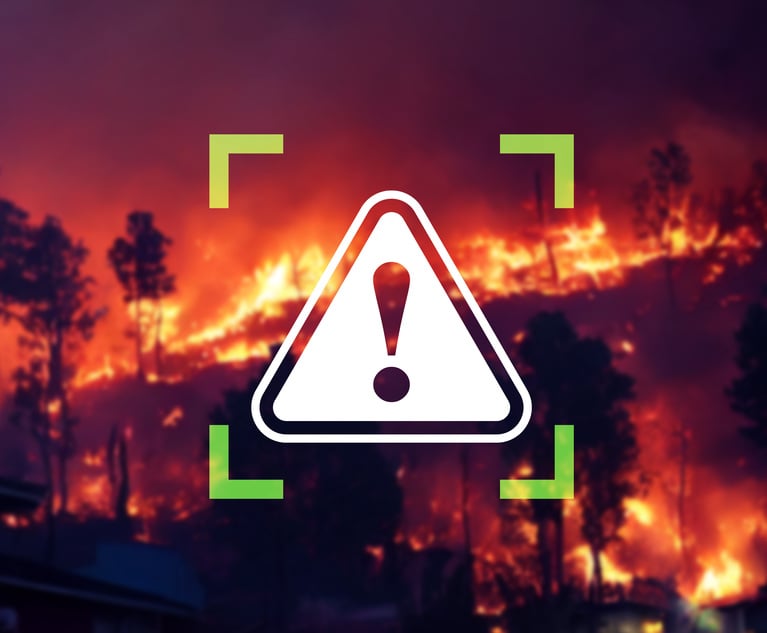Court Upholds State Farm Causation Language
|A federal appeals court panel in New Orleans rejected a lowercourt's ruling that permitted a Mississippi couple to pursue ahurricane damage claim even when policy-excluded flood damage wasinvolved.
|The decision by the 5th U.S. Circuit Court of Appeals overturnsa ruling by U.S. District Court Judge L.T. Senter Jr. in Gulfport,Miss., that ruled out a portion of State Farm's policy language asambiguous.
|State Farm was sued by Long Beach, Miss., homeowners John andClaire Tuepker after their home was reduced to a foundation slab byHurricane Katrina and the insurer refused to pay for thedamage.
|At issue was language in the State Farm policy's anti-concurrentcausation (ACC) clause that rules out payment for covered winddamage claims when they occur at the same time as flooding, whichthe policy does not cover.
|The appeals court found that “the ACC clause in State Farm'spolicy is not ambiguous and should be enforced under Mississippilaw.” Under the appeals court ruling the Tuepker case iseffectively ended because before a jury could rule whether StateFarm owed the couple damages, the insurer reached a settlementwhere the amount to be paid would be based on the outcome of theappeal. Had the Tuepkers won the appeal, their settlement wouldhave been higher.
|Fitch Reports Capital Levels Soared in 2006
|The U.S. life insurance industry has been overcapitalized, andthat level of overcapitalization increased in 2006. Douglas Meyer,a managing director in Fitch Ratings' Chicago office, gave thatassessment during a teleconference focusing on the firm's Prismcapital model.
|Fitch has incorporated the Prism model, which relies onstochastic forecasting techniques, into the rating process the firmuses both for life insurers and property/casualty insurers.Stochastic modeling involves use of computer simulations todetermine how a product or company might perform under a wide rangeof randomly changing conditions.
|The U.S. life industry ended 2006 with $253 billion in capital,or about $54 billion more capital than it needed to meet the Prismaggregate AAA rating standard, Meyer said.
|At the end of 2005, the industry had $249 billion in capital, orabout $45 billion more capital than it needed to meet the AAAstandard, Meyer said. The average Prism score for the U.S. lifeuniverse as a whole held steady in 2006 at AA plus.
|For the life insurance sector and large mutual insurers, theoverall Prism rating was AAA.
|The overall Prism rating was AA plus for the annuity sector,large stock companies, foreign-owned companies, and life/healthcompanies.
|Spain's MAPFRE Buys Commerce Group
|Spain's largest insurer, MAPFRE, and the Webster, Mass.-basedCommerce Group, Inc., have signed an agreement for MAPFRE toacquire the auto carrier in a $2.2 billion cash deal. MAPFRE saidit will purchase 100 percent of Commerce share capital.
|Domingo Sugranyes, MAPFRE vice president, said the purchase waspart of his company's plan to establish “a presence in the UnitedStates with a well-developed plan to address the Hispaniccommunity” and the population as a whole and to move step by stepinto other states. Commerce, he said, would serve as a “very solidplatform.”
|He noted MAPFRE already has a small bilingual operation inFlorida that can be used in other states, and MAPFRE Re can providereinsurance solutions for Commerce.
|The company, Sugranyes indicated, is investing “when theexchange rate is very favorable.”
|When completed, Commerce shareholders would receive $36.70 pershare, representing a 22.5 percent premium over the average shareprice of the past 30 days.
|Senate Passes TRIA Extension Bill
|The Senate whisked through without comment legislation extendingthe federal backstop for insurers' terrorism risk for seven years,through 2014. The decision, through a unanimous consent procedure,represents a virtual barebones extension of the currentlegislation, the Terrorism Risk Extension Act of 2005.
|It sets up a confrontation with the House, whose leadershipinsists at least some of the provisions of its more expansivelegislation be included in the final bill. But the fact the billpassed before Congress departs for a two-week break means talksbetween House and Senate staff to reconcile the different bills cantake place before the Senate returns to work Dec. 3 and the HouseDec. 4.
|That means, even though Congress has a huge backlog of must-dowork to complete before it recesses for the year, it may be able tomove promptly.
|In comments several weeks ago in Boston, Rep. Barney Frank,D-Mass., vowed not to accept the latest Senate version, saying hewas prepared to ask for an extension of the current bill untilApril 30 so meaningful talks on a compromise can take place.
|However, the Senate appears to hold most of the cards,especially since the Bush administration has indicated it would“not oppose” the Senate bill but would consider a veto if moreprovisions were added to it.
|Learn Predictive Technology or Die, Insurers Told
|Insurers that don't master both the art and science ofpredictive technology are at risk of falling behind theircompetitors, cautioned the head of Insurance Services Office at anindustry conference. “We are at the beginning of an intellectualand technological arms race that will remake the insurancebusiness,” said Frank J. Coyne, chairman, president, and chiefexecutive officer of ISO.
|Coyne spoke at the ISOTECH technology conference in New Orleans.“Insurers that succeed in developing and deploying advancedanalytics all along the value creation chain can look forward to along and prosperous future if they continue to invest in new andbetter analytics and new and better data,” he said. “Other insurersface a far different future, with even the best of the best todaybeing at risk of falling behind as new technologies comeonline.”
|Coyne noted “escalating competitive pressures cut the number ofinsurers serving the United States by a third in a decade and ahalf,” and carriers face a prospect of ever-increasing catastrophelosses. Rapid technology advances mean “huge changes are just overthe horizon for lines ranging from personal auto to workers'comp.”
|California Fire Losses Mount; State Farm Tallies 2,000-PlusClaims
|A catastrophe modeling firm has estimates California wildfirelosses will go well above $1 billion, and the state's largest homeinsurer–State Farm–said it already has logged 2,000 claims.Meanwhile, there was divided opinion on the amount of claimslitigation that could result once the flames are extinguished.
|The latest modeling firm estimate came from Boston-based AIRWorldwide Corp., which said insured losses were likely to exceed$1.5 billion. There also was an estimate from Impact Forecasting, aunit of Aon Corporation, that insured losses would be between $1.2billion and $1.6 billion.
|Previously, Risk Management Solutions said estimated damagecould range from $900 million to $1.6 billion. Eqecat in Oakland,Calif., put out an estimate of a $1 billion loss it said could gohigher.
|State Farm said of the claims it has received, nearly 500 of thehomes involved are either destroyed or damaged to the point theyare uninhabitable. The number of claims should rise, the companysaid, as claims adjusters, local claims staff, and agents makecontact with policyholders who evacuated their homes.
|LISA Blasts STOLI Alert
|The Life Insurance Settlement Association is criticizing arecent industry group warning against “stranger-owned lifeinsurance.”
|The American Council of Life Insurers and the NationalAssociation of Insurance and Financial Advisors issued the third ina series of “STOLI Alert” last month.
|The latest notice describes the groups' position on STOLI andregulatory efforts to keep strangers from helping consumers buylife insurance mainly to create policies that can be sold throughthe life settlement market. LISA said the latest STOLI notice is“highly misleading and full of errors.”
|LISA has responded to the STOLI Alert by issuing its own notice,“Be Alert to STOLI Alert,” in which it warned, “The STOLI Alertsare put forth in broad mailings to agents and policy makers as ifthey are factual and documented. The truth is that these STOLIAlerts are, at best, highly misleading and inconsistent efforts.The STOLI Alerts contain assertions which contradict the ACLI's ownpositions and which misinterpret the cases and examples which theycite.”
|LISA objects to an alert statement suggesting STOLI transactionsare hard to detect.
|Some of the STOLI court cases the STOLI alert authors haveidentified show STOLI transactions can be easily identified, LISAsaid.
|Insurance Sector Hit Hardest By Economic Crime
|Among industry sectors, the insurance business is the biggestvictim of economic crime, a global study by a major consultinggroup has found.
|Total average cost of economic crime losses for insurancebusinesses over two years is $5.5 million, while average directlosses were $4.47 million, according to the annual “Global EconomicCrime Survey,” by PricewaterhouseCoopers.
|The loss figures for insurers were almost double the globalaverage for businesses and slightly above that of the industrialmanufacturing sector, which PwC said had an average fraud cost ofabout $5 million.
|Steven L. Skalak, leader of PwC investigative practice, believesthe survey found the level of economic crime has been consistent.“We're not having a wave of economic crime, but it is continuingunabated,” he said.
|The company defines economic crime as asset misappropriationthat can involve stealing physical or cash assets or, in the caseof insurers, false claims. “Insurance is attacked by outsiders.Most businesses are attacked by their own employees,” Skalaksaid.
|Hartford Reports Security Breach
|Hartford Financial Services Group said it appears to have“misplaced” computer tapes with sensitive personal informationbelonging to 237,000 property/casualty customers.
|The insurer reported it noticed the data was missing in lateSeptember and notified the Ohio Department of Insurance of the datasecurity breach. In addition to searching for the three backuptapes, the company explained it is investigating the incident andnotifying all affected individuals.
|Mary Jo Hudson, Ohio Department of Insurance director, announcedshe had asked the carrier for more information about the missingdata and for documentation of The Hartford's established securityprocedures. She asked for a written response by Nov. 16.
|Shannon Lapierre, The Hartford spokesperson, said the companyhas no information the tapes have been stolen or the information onthem has been improperly accessed. She said the information on thetapes can only be accessed with sophisticated equipment.
|She added as a precaution, all the affected individuals arebeing given identity theft protection service at no cost, freecredit file monitoring, and $20,000 in identity theftinsurance.
Want to continue reading?
Become a Free PropertyCasualty360 Digital Reader
Your access to unlimited PropertyCasualty360 content isn’t changing.
Once you are an ALM digital member, you’ll receive:
- All PropertyCasualty360.com news coverage, best practices, and in-depth analysis.
- Educational webcasts, resources from industry leaders, and informative newsletters.
- Other award-winning websites including BenefitsPRO.com and ThinkAdvisor.com.
Already have an account? Sign In
© 2024 ALM Global, LLC, All Rights Reserved. Request academic re-use from www.copyright.com. All other uses, submit a request to [email protected]. For more information visit Asset & Logo Licensing.








